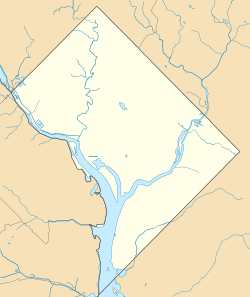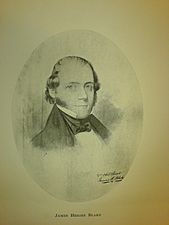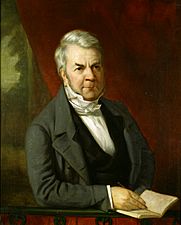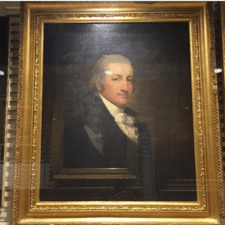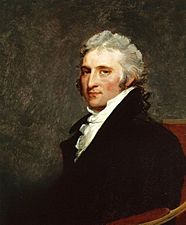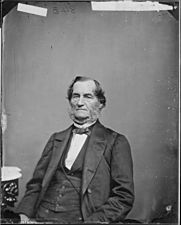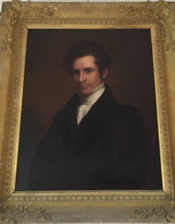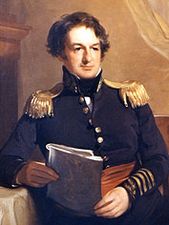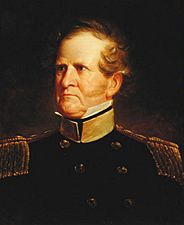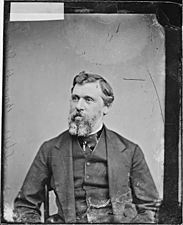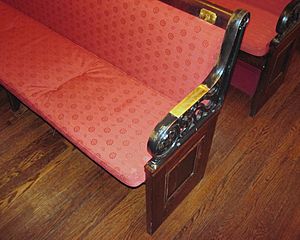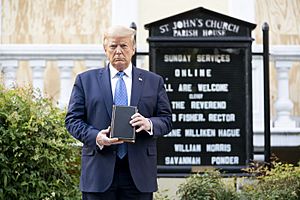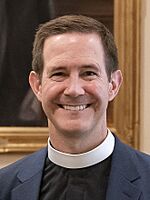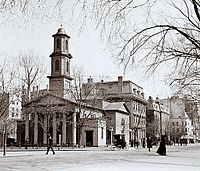St. John's Episcopal Church, Lafayette Square facts for kids
|
St. John's Episcopal Church
|
|
|
U.S. National Historic Landmark District
Contributing Property |
|
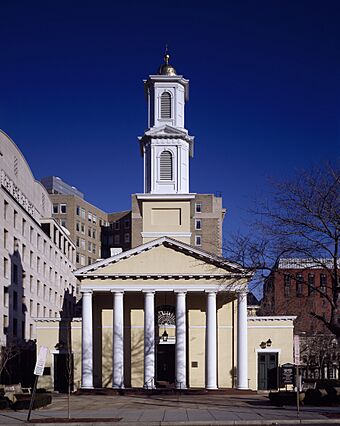 |
|
| Location | 1525 H Street, N.W., Washington, D.C., U.S. |
|---|---|
| Built | 1816 |
| Part of | Lafayette Square Historic District (ID70000833) |
| NRHP reference No. | 66000868 |
Quick facts for kids Significant dates |
|
| Added to NRHP | October 15, 1966 |
| Designated NHL | December 19, 1960 |
| Designated NHLDCP | August 29, 1970 |
St. John's Episcopal Church, Lafayette Square is a very old and important church in Washington, D.C.. It is located near Lafayette Square, which is just one block away from the White House. Because of its close ties to American presidents, it is often called the "Church of the Presidents."
Since it was built in 1816, every single sitting president has visited St. John's at least once. The first president to attend was James Madison. Many important spiritual services for Inauguration Day have also taken place here. The church was recognized as a National Historic Landmark in 1960, meaning it is a very special place in American history.
Contents
History of St. John's Church
St. John's Church was officially started as a church group in 1815. It was named after Saint John the Evangelist. The church building first opened its doors, and the very first service was held on October 27, 1816. The Rev. William Dickinson Hawley was the church's leader, called a rector, from 1817 to 1845. He also served as the Chaplain of the Senate.
How the Church Started
In 1814, people living in the central part of Washington, D.C., decided they needed a new church. They wanted a place of worship closer to where they lived. Many important citizens worked together to make this happen.
On May 10, 1816, a group of citizens met and chose trustees to manage the church's affairs. These trustees included John Davidson, Peter Hagner, James Thompson, John Peter Van Ness, John Tayloe III, Thomas H Gillis, James H. Blake, and Roger C. Weightman.
On December 27, 1816, Bishop James Kemp officially dedicated the church. The building was designed by Benjamin Latrobe, who also designed parts of the U.S. Capitol Building. Mr. Latrobe did not want to be paid for his work. Instead, the church gave him a special gift to thank him. John Tayloe III also gave the church a silver communion set.
Making the Church Bigger
By 1842, the church needed more space for people to sit. A committee was formed to plan how to add more seats and improve the church. In 1843, big changes were made. The old box-like pews were replaced with new, lower seats. The church's layout was changed, and the area around the altar was made larger.
More changes happened in 1883. Most of the windows were replaced with beautiful stained glass. The altar area was made even bigger, and a new organ was installed. New rooms were added for the church's leaders and choir. These changes added at least 180 more seats, bringing the total to 780.
-
Bishop William Meade
-
Winfield Scott in 1835
In 1902, a very important funeral was held at St. John's Church for Lord Pauncefote, who was the British ambassador.
The "Church of the Presidents"
St. John's Church is known as the "Church of the Presidents" because every U.S. president has attended a service there at least once. This tradition started with President James Madison. The church is very close to the White House, which makes it easy for presidents to visit.
One of the presidents who visited most often was Abraham Lincoln. He would often attend evening prayers during the Civil War, sitting quietly in a back pew.
President James Madison started the tradition of a "president's pew" in 1816. He chose pew 28 for his own use. Even though the church offered it to him for free, he insisted on paying for it. During a renovation in 1843, the pews were renumbered, and the president's pew became pew 58. President John Tyler then asked for pew 58 to be assigned to him and paid for it to be used by presidents forever. After more changes in 1883, the pew was renumbered to 54. This pew is still kept for the president to use when they attend church. However, during special events like weddings, the president usually sits in the front row as a matter of official custom.
President Chester A. Arthur had a special stained-glass window made to remember his wife, Ellen Lewis Herndon Arthur, who passed away in 1880. This window was placed in the church's south side, where it could be seen from the White House. President Arthur even asked for it to be lit up from the inside.
Events During the George Floyd Protests
On the night of May 31, 2020, during the George Floyd protests, a small fire was set in the basement of Ashburton House. This building is the parish house of St. John's Episcopal Church. Firefighters quickly put out the fire, which was limited to the church nursery. The church's rector, Rev. Rob Fisher, stated that the fire destroyed the nursery room but left the rest of the church untouched, except for some graffiti.
The next day, police and National Guard troops cleared the area around the church. The Episcopal Bishop of Washington, Mariann Budde, who oversees the church, expressed her concerns about the use of force to clear the church grounds for a photo opportunity.
Design and Architecture
In 1966, St. John's Church was added to the National Register of Historic Places. This means it is recognized as an important historical site by the U.S. government. It is also part of the Lafayette Square Historic District.
The church building was designed by Benjamin Latrobe, a famous architect who also designed parts of the U.S. Capitol Building. The church is made of stucco-covered brick and is shaped like a Greek cross. In 1820, a front porch, called a portico, and a tower were added.
The bell in St. John's steeple is very heavy, weighing almost 1,000 pounds (about 450 kg). It was made by Paul Revere's son, Joseph, in Boston in August 1822. The bell was installed at St. John's on November 30, 1822. President James Monroe even gave $100 from public funds to help buy this bell. The bell was used not only for church services but also as an alarm for the nearby neighborhoods and public buildings. St. John's bell is one of only two bells made by the Revere family in Washington, D.C., and it is the only one that has been used continuously since it was installed.
Inside the church, there are artworks, including two sculptures by Jay Hall Carpenter. One is a polished brass cross, and another is a bronze angel and child sculpture called Ascent Into Heaven.
See also
 In Spanish: Iglesia Episcopal de San Juan (Washington D. C.) para niños
In Spanish: Iglesia Episcopal de San Juan (Washington D. C.) para niños



